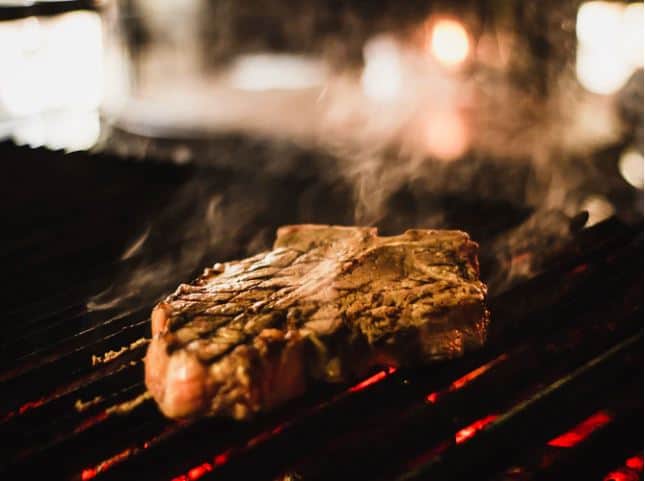Red meat is a food with many benefits for the human being. At the same time, it is a food source that carries many risks to human health.In recent decades, the world consumption of red meat has been increasing sharply, particularly in developing countries. However, more and more scientific studies indicate that the consumption of large quantities of red meat, particularly, processed meat, is associated with an increasing risk of several chronic diseases. Including cardiovascular diseases, type 2 diabetes, and certain types of cancers, as well as an increased risk of mortality.
1. Processed red meat
"Red meat" is a food made up of muscle tissue from mammals such as beef, veal, pork, horse, lamb, and mutton, generally consumed after cooking. The red color of this type of meat is mainly due to the presence in high concentration of myoglobin, which by binding to oxygen, turns into red-colored oxymyoglobin. Myoglobin is a protein-related to hemoglobin (both contain a prosthetic grouping "heme" linked to iron), but the function of myoglobin is to store oxygen in the muscles rather than to transport it as it is the case for hemoglobin in red blood cells. Processed meats are subjected to various treatments to increase their shelf life (maturation, salting, smoking, the addition of preservatives). Products are also added to improve taste, color, tenderness, juiciness, and consistency. Examples of processed meats are ham, sausages, bacon, salami, and other deli meats. Most processed meats contain pork or beef but may also contain other types of red meats, poultry, organ meats, or blood (black pudding).
2. Characteristics
By red meat, nutrition professionals gather beef, mutton, lamb, and horse.They have in common:
- A more or less intense red color due to the presence of myoglobin in the muscle.
- High protein content: on average, 20% (from 17 to 24%) well assimilated by the body with the presence of all the essential amino acids.
- A very interesting supply of minerals, in particular iron, zinc, and selenium.
- Vitamin B group intake and mainly B3 and B12.
- Absence of carbohydrates (sugars) or simple traces: because glycogen (a form of storage of glucose in the body) is transformed into lactic acid after the death of the animal. This lactic acid exerts a favorable action on the maturation of the meat.
- In the raw state and before cooking, red meats contain 60 to 70% water.
What differentiates red meats from each other and even within a category is their lipid (fat) content. Indeed, the lipid content varies according to the pieces. For beef, for example, the sirloin or steak contains very little fat (3 to 4%), while a rib steak provides about 17%.We must, therefore, distinguish the place of fat in the animal: the subcutaneous adipose tissue, the tissue that surrounds the viscera and intramuscular lipids, and those located between the constituent bundles of the muscle that give the marbled appearance to meat.In general, mutton and lamb contain more fat (on average 17 g of fat per 100 g) than that of beef (on average 7%) and very lean horse (2 to 3%).
3. Benefits of Red meat
Red meat is a very interesting source of protein, iron, and B vitamins essential for the proper functioning of the body.The benefits are linked to its nutritional composition:
- The constructive role of proteins: for the renewal of the cells of our body, those of the muscles in particular.
- The presence of all amino acids (which constitute proteins) of which 9 are essential because the body does not know how to manufacture them.
- Vitamin B3 (or niacin) present in an interesting quantity has different roles: antioxidant and cell protection, energy metabolism, and cholesterol.
- Vitamin B12, found only in animal products, is involved in the formation of hemoglobin, the synthesis of DNA, and neurotransmitters among others.
- Heme iron (found in myoglobin) is better absorbed by the body than non-heme iron (in plant foods): it is involved in many enzymatic reactions inside cells and enters into the composition hemoglobin in red blood cells, promoting the transport of oxygen in all organs.
- The richness in zinc strengthens the body's immune defenses and improves neurological and reproductive functions.
- The richness in selenium, an essential trace element which has an antioxidant effect and is essential in the functioning of the immune system.
Red meat is an interesting food for growing children, adolescents, and pregnant women in particular. To keep the beneficial effects, it is necessary to adjust the quantities of consumption according to its needs and, especially to vary the type of meat.
4. Dangers
Red meat has a bad press because many studies have shown harmful effects on health, especially for beef:
- Risk of developing colon cancer and cardiovascular disease.
- The danger of becoming obese and type 2 diabetic.
These risks are even higher when the daily consumption exceeds 250 g.The latest study from the International Agency for Research on Cancer (IARC), dependent on the WHO (World Health Organization), published in October 2015. Classifies red meat as probably carcinogenic, and the consumption of cold meats as carcinogenic for humans.Among those responsible for the harmful health effects of eating red meat are:
- Saturated fatty acids, more numerous than in white meats, fish, and seafood.
- Iron, present in large quantities, all the more if consumption is very high.
- The cooking method: barbecue and over-grilled meat, favoring the appearance of carcinogenic compounds.
Recommendations to limit the consumption of meat to 500 g per week at most, to vary the sources of animal protein (meat, eggs, fish) and types of meat, as part of a balanced diet.Important to know: it is the consumption of processed meat (charcuterie products such as ham, corned beef, dried beef, canned meats, and meat preparations and sauces) that would cause the most dangers to our health, in particular colorectal cancer.
4.1 Heart diseases
Some types of red meat are relatively high in saturated fats, which leads to high blood cholesterol. The high levels of low-density lipoprotein may increase the risk of heart disease. A recent study demonstrated more than half a million American adults who had most of their food from red meat and processed meats for 10 years were more likely to die prematurely than older adults who consumed less, and people who ate 133 grams a day were more likely to die due to heart diseases and cancer compared to people who consumed 42.5 grams a day, at least.
4.2 Cancer
Believes that the main type of cancer caused by red meat is colorectal cancer, which is the fourth type globally among the most common types of cancer. Still, most studies have gathered the effect of processed meat and unprocessed on cancer, as other studies indicate that red meat has any negative impact on health, but the formation of harmful compounds when cooking the meat, may increase the risk of eating it, so the method of cooking meat may determine its effect on the body.
4.3 Diabetes type 2
Over the past decade, a considerable number of prospective studies have shown that a diet rich in red meat and processed meat is associated with an increased risk of type 2 diabetes. The most recent meta-analysis indicates that the risk of type 2 diabetes increases by 15% for each serving (100 g / day) of unprocessed meat (11 studies), by 32% for each serving (50 g / day) of processed meat (21 studies).For each 100 g / day portion of poultry, "white meat," the increased risk (4%) was not statistically significant (10 studies). The compounds in red or processed meat that contribute to the increased risk of type 2 diabetes have not yet been identified with certainty. Still, several compounds have been proposed, including branched-chain amino acids, saturated fatty acids, glycation end products, heme iron, nitrite, nitrate, nitrosamine, phosphatidylcholine, and L-carnitine.In summary, science indicates that the consumption of red meats, particularly processed meats, increases the risk of several chronic diseases, including cardiovascular disease, type 2 diabetes, and cancer. Ceasing or reducing our consumption of this meat could allow us to live healthier and longer lives, in addition to reducing the degradation of our environment caused by intensive farming.
- What is the ideal healthy diet for diabetics people?
- Does a vegetable diet reduce the risk of diabetes and heart diseases?
- Brown vs white rice, which one is better for your health?
Originally published on Live Positively.






